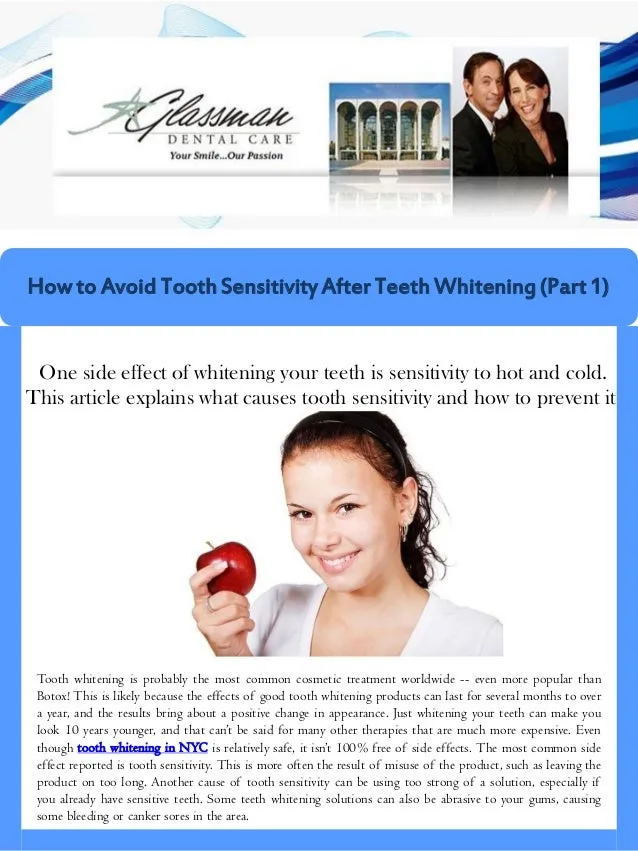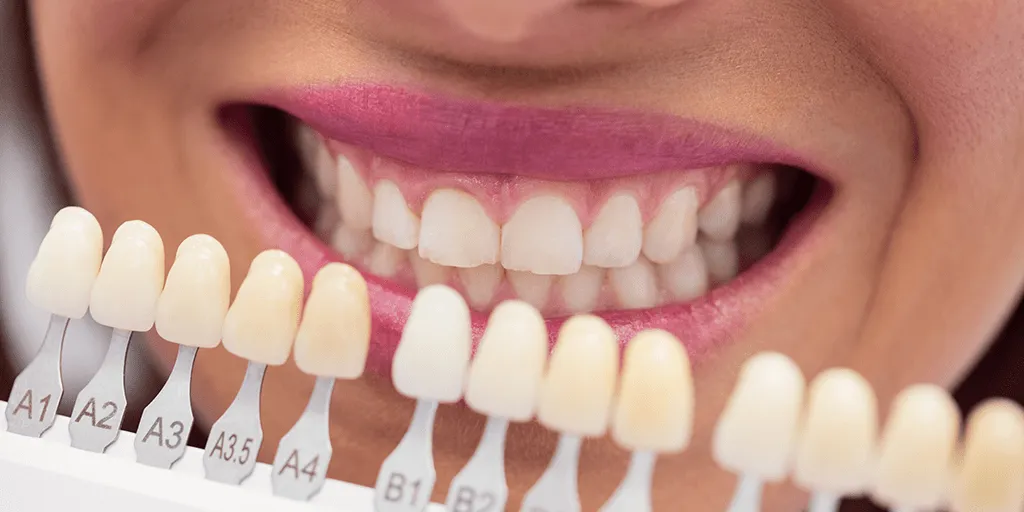What Causes Tooth Sensitivity After Whitening?
Tooth sensitivity is a common side effect of teeth whitening treatments. The process of whitening teeth involves using bleaching agents, typically hydrogen peroxide or carbamide peroxide, to break down stains and discolorations on the enamel. This process can sometimes lead to temporary sensitivity. The bleaching agents penetrate the enamel and reach the dentin, the layer beneath the enamel that contains tiny tubules. These tubules lead to the nerve of the tooth, and when they are exposed or irritated, it can cause sensitivity. The intensity of sensitivity varies from person to person, depending on factors such as the concentration of the bleaching agent, the duration of the treatment, and the individual’s tooth structure and existing dental conditions. The temporary nature of this sensitivity is a crucial point. While uncomfortable, it usually subsides within a few days or weeks after the whitening treatment is completed. Understanding the causes is the first step in finding effective relief.
The Science Behind Whitening and Sensitivity
The science behind teeth whitening and the resulting sensitivity involves a complex interplay of chemical reactions and the unique structure of our teeth. The active ingredients in whitening products, such as hydrogen peroxide, work by releasing oxygen molecules that break down the stain-causing compounds within the enamel. However, this process isn’t without its impact on the tooth’s internal structures. The enamel, while being the hardest substance in the human body, is porous. The whitening agents seep into these pores, reaching the dentin layer. Dentin contains microscopic tubules that house nerve endings. When the whitening agents come into contact with these nerves, it triggers a sensation that we perceive as sensitivity. Furthermore, the bleaching process can cause the enamel to become slightly dehydrated, leading to increased permeability and further irritation. The degree of sensitivity is influenced by the concentration of the whitening agent, the duration of its application, and individual variations in tooth structure. The body’s natural response involves a process of rehydration and remineralization, which helps to alleviate the sensitivity over time.
Common Causes of Tooth Sensitivity After Whitening

Several factors contribute to the development of tooth sensitivity following a teeth whitening treatment. One of the most common causes is the concentration of the bleaching agent used. Higher concentrations of hydrogen peroxide or carbamide peroxide, which are often found in professional whitening treatments, can lead to more significant sensitivity. The duration of the treatment also plays a role; longer exposure to the whitening agent can increase the likelihood of sensitivity. Additionally, the existing condition of your teeth can influence how sensitive they become. Individuals with thinner enamel, receding gums, or pre-existing cavities are more prone to experiencing sensitivity. Over-the-counter whitening products, while generally milder, can still cause sensitivity, especially if used excessively or incorrectly. Furthermore, the use of whitening products on teeth that have cracks, chips, or other structural issues can exacerbate the problem. Finally, the method of whitening, whether it’s in-office, at-home trays, or whitening strips, can influence the degree of sensitivity experienced. Understanding these causes empowers you to make informed choices and take preventative measures to minimize discomfort.
How to Manage Tooth Sensitivity
Managing tooth sensitivity after whitening involves a multi-faceted approach that combines immediate relief with long-term preventative strategies. The primary goal is to alleviate the discomfort caused by the whitening process and to protect your teeth from further irritation. Begin by using a sensitive toothpaste, which contains ingredients like potassium nitrate that help to block the nerve signals that cause sensitivity. Avoid overly hot or cold foods and drinks, as these can trigger sensitivity. Consider using a soft-bristled toothbrush and brushing gently to avoid further irritation of the enamel and gums. Over-the-counter pain relievers, such as ibuprofen, can help manage any pain or discomfort. If sensitivity persists, consult with your dentist for more advanced treatments. Your dentist might recommend fluoride treatments to strengthen the enamel or desensitizing agents to block the nerve endings. Following a proper oral hygiene routine and making smart lifestyle choices are also essential for long-term comfort and a healthy smile. The key is to be proactive and adapt your oral care practices to the temporary changes in your teeth after the whitening process.
Use Sensitive Toothpaste for Relief
Sensitive toothpaste is a cornerstone of managing tooth sensitivity. These specially formulated toothpastes contain active ingredients designed to address the root causes of sensitivity. Potassium nitrate is a common ingredient that works by blocking the nerve signals from the tooth to the brain, thereby reducing the pain sensation. Other ingredients, such as stannous fluoride, can help to strengthen the enamel and protect against further sensitivity. When choosing a sensitive toothpaste, look for options that are specifically designed for post-whitening care. Consistency is key; it often takes several days or even weeks of regular use to experience the full benefits. Apply the toothpaste to your toothbrush and brush gently, ensuring that all surfaces of your teeth are covered. You can also apply a small amount of toothpaste directly to the sensitive areas and leave it for a few minutes before rinsing. This allows the active ingredients to have more direct contact with the sensitive spots. Using sensitive toothpaste alongside other management strategies, such as avoiding extreme temperatures and maintaining good oral hygiene, will significantly enhance your comfort during and after teeth whitening.
Proper Brushing Techniques

Proper brushing techniques are critical in preventing and managing tooth sensitivity. Brushing too hard or using a toothbrush with hard bristles can wear away the enamel and irritate the gums, exacerbating sensitivity. Always use a soft-bristled toothbrush, and brush your teeth gently using small, circular motions. Apply minimal pressure, focusing on cleaning the teeth and gums without causing abrasion. The goal is to effectively remove plaque and bacteria without damaging the tooth structure. Brushing for at least two minutes, twice a day, is recommended. Make sure to brush all surfaces of your teeth, including the outer, inner, and chewing surfaces. Pay extra attention to the gumline, where sensitivity is often most pronounced. Consider angling your toothbrush at a 45-degree angle to the gumline to effectively clean this area. Avoid brushing immediately after consuming acidic foods or drinks, as this can soften the enamel and make it more susceptible to erosion. Instead, wait at least 30 minutes before brushing. Implementing proper brushing techniques is a simple yet powerful way to protect your teeth and manage the discomfort associated with sensitivity.
Over-the-Counter Remedies for Sensitivity
Several over-the-counter remedies can help alleviate tooth sensitivity. Sensitive toothpastes are the most common and effective solution, containing ingredients like potassium nitrate to block nerve signals. However, there are other options to consider. Over-the-counter fluoride mouthwashes can strengthen the enamel and reduce sensitivity. These mouthwashes are available in various formulations, but it’s essential to select one that’s alcohol-free to avoid further irritation. You can also use desensitizing gels that you apply directly to the sensitive areas. These gels often contain fluoride or other desensitizing agents. Over-the-counter pain relievers, such as ibuprofen or acetaminophen, can help manage any pain or discomfort associated with sensitivity. Always follow the instructions on the packaging and do not exceed the recommended dosage. Additionally, you can use a desensitizing toothpaste as a pre-treatment before whitening to potentially reduce post-whitening sensitivity. If sensitivity is severe or persistent, it’s essential to consult with your dentist, as these remedies may not provide sufficient relief and professional intervention may be required.
Fluoride Treatments and Their Benefits
Fluoride treatments are a valuable tool in managing tooth sensitivity. Fluoride works by strengthening the tooth enamel, making it more resistant to acid attacks and reducing the permeability of the dentin tubules. This helps to block the nerve signals that cause sensitivity. Fluoride treatments can be administered in several ways. Your dentist may apply a concentrated fluoride varnish directly to your teeth during a professional cleaning. These varnishes are easy to apply and provide a high concentration of fluoride. Your dentist may also prescribe a fluoride toothpaste or mouthwash with a higher concentration of fluoride than over-the-counter options. You can use these products as part of your daily oral hygiene routine. Furthermore, some dentists offer fluoride trays that you can use at home. These trays allow for a more prolonged exposure of the teeth to fluoride. The benefits of fluoride treatments extend beyond reducing sensitivity. They also help prevent tooth decay by remineralizing the enamel and making it more resistant to bacterial acids. Regular fluoride treatments, combined with good oral hygiene practices, can significantly improve your oral health and reduce the discomfort associated with tooth sensitivity.
Professional Dental Solutions

If over-the-counter remedies don’t provide sufficient relief, professional dental solutions are often necessary to manage tooth sensitivity effectively. Your dentist can offer several treatments tailored to your specific needs. One common solution is a professional fluoride treatment, which provides a higher concentration of fluoride than over-the-counter products. Your dentist may also recommend desensitizing agents, such as fluoride varnishes or other topical applications, to block the nerve signals that cause sensitivity. In some cases, your dentist may apply dental sealants to protect the exposed dentin and reduce sensitivity. For more severe cases, your dentist might consider dental bonding. This procedure involves applying a resin material to the sensitive areas to protect them from further irritation. If receding gums are a contributing factor to the sensitivity, your dentist might recommend gum grafts. Your dentist can also address any underlying dental issues, such as cavities or cracked teeth, which can exacerbate sensitivity. Regular dental check-ups and professional cleanings are essential for early detection and treatment of any dental problems that may contribute to sensitivity. Your dentist will assess your oral health, determine the underlying causes of your sensitivity, and recommend the most appropriate treatment plan.
Desensitizing Treatments from Your Dentist
Desensitizing treatments from your dentist are specifically designed to provide relief from tooth sensitivity. These treatments work by blocking the nerve signals that cause pain or by sealing the dentin tubules, thereby preventing stimuli from reaching the nerve. Dentists use a variety of desensitizing agents, including fluoride varnishes, which they apply directly to the sensitive areas. These varnishes contain a high concentration of fluoride that strengthens the enamel and reduces sensitivity. Another common treatment involves applying a desensitizing agent that blocks the dentin tubules. These agents can be applied directly to the tooth surface. Some dentists may use a laser to treat sensitive teeth. The laser can help to seal the dentin tubules, reducing sensitivity. For individuals with receding gums, your dentist might recommend gum grafts to cover the exposed tooth roots. The dentist will evaluate your specific needs and recommend the most appropriate desensitizing treatment. They will also provide guidance on maintaining good oral hygiene practices to prevent future sensitivity. These treatments are often more effective than over-the-counter options and provide significant relief from the discomfort associated with sensitive teeth.
Other factors that can make the situation worst
Several factors can exacerbate tooth sensitivity, prolonging discomfort after a teeth whitening treatment. Dietary choices play a significant role. Acidic foods and drinks, such as citrus fruits, tomatoes, and carbonated beverages, can erode the enamel and irritate sensitive teeth. Consuming these foods and drinks frequently can make sensitivity worse. Teeth grinding, or bruxism, can wear down the enamel and expose the dentin, increasing sensitivity. Stress and anxiety are often linked to bruxism. Using a hard-bristled toothbrush or brushing too aggressively can also contribute to enamel erosion and gum recession. Additionally, certain oral hygiene products can worsen sensitivity. Toothpastes containing harsh abrasives or whitening agents can further irritate sensitive teeth. Underlying dental conditions, such as cavities, cracked teeth, or gum disease, can exacerbate sensitivity. Any existing dental issues need to be addressed. Moreover, certain medical conditions, such as gastroesophageal reflux disease (GERD), can increase tooth sensitivity. The stomach acid that flows back into the mouth can erode the enamel. Understanding these factors allows you to take proactive steps to mitigate their impact on tooth sensitivity.
Foods and Drinks to Avoid

Avoiding certain foods and drinks is crucial to manage tooth sensitivity and promote healing after teeth whitening. Acidic items are major culprits. Citrus fruits like lemons, limes, and oranges, along with tomatoes, pickles, and vinegar-based dressings, can erode the enamel and irritate sensitive teeth. Carbonated beverages, including soda and sparkling water, also contain acids that can worsen sensitivity. Sugary foods and drinks can contribute to tooth decay, which can exacerbate sensitivity. Sticky sweets, candies, and high-sugar beverages should be limited. Very hot or cold foods and drinks can trigger sensitivity, as they can directly stimulate the nerves in the teeth. Spicy foods, which contain capsaicin, can also cause discomfort. Focus on a balanced diet. Choose foods that are gentle on your teeth. Dairy products like milk, cheese, and yogurt can help neutralize acids and provide calcium to strengthen your enamel. Vegetables and fruits are generally safe options. Drink plenty of water, especially after eating to rinse away any lingering acids. By making smart dietary choices, you can significantly reduce the discomfort associated with tooth sensitivity and support your overall oral health.
Oral Hygiene Practices During Treatment
Maintaining good oral hygiene during and after teeth whitening is essential to manage sensitivity and promote healing. The primary goal is to keep your teeth clean without causing further irritation. Always use a soft-bristled toothbrush and brush gently, using small, circular motions. Apply minimal pressure to avoid abrasion of the enamel and gums. Choose a sensitive toothpaste that contains ingredients like potassium nitrate or stannous fluoride to block nerve signals and strengthen enamel. Brush your teeth for at least two minutes, twice a day, and make sure to clean all surfaces of your teeth, including the outer, inner, and chewing surfaces. Floss daily to remove plaque and food particles from between your teeth. Avoid using aggressive flossing techniques that can irritate your gums. Rinse your mouth with an alcohol-free fluoride mouthwash after brushing to further strengthen your enamel and reduce sensitivity. Avoid using whitening toothpastes or mouthwashes during this time, as they may contain abrasive agents. Consider using a gentle tongue scraper to remove bacteria and debris from your tongue. Follow your dentist’s recommendations for post-whitening care. This may include additional treatments or specific oral hygiene instructions. Careful and consistent oral hygiene is a cornerstone of managing sensitivity and maintaining a healthy smile.
Maintaining a Healthy Smile After Whitening
Maintaining a healthy smile after teeth whitening involves adopting a proactive approach to oral care. This ensures you not only enjoy your brighter smile but also minimize the risk of future sensitivity and other dental issues. Continue with a regular oral hygiene routine, brushing your teeth twice a day with a soft-bristled toothbrush and a sensitive toothpaste. Floss daily to remove plaque and food particles from between your teeth. Schedule regular dental check-ups and professional cleanings every six months. Your dentist can assess your oral health, detect any potential problems early, and provide appropriate treatment. Limit your consumption of staining foods and drinks. This includes coffee, tea, red wine, and highly pigmented foods. If you do consume these items, rinse your mouth with water afterward to minimize their impact. Consider using a straw for beverages to reduce contact with your teeth. Avoid smoking and using tobacco products. These habits not only stain your teeth but also increase your risk of gum disease and other oral health problems. Follow a balanced diet. Ensure that you are getting enough calcium and other nutrients to strengthen your teeth. By consistently practicing good oral hygiene, avoiding staining substances, and attending regular dental check-ups, you can maintain your bright, healthy smile for years to come.
